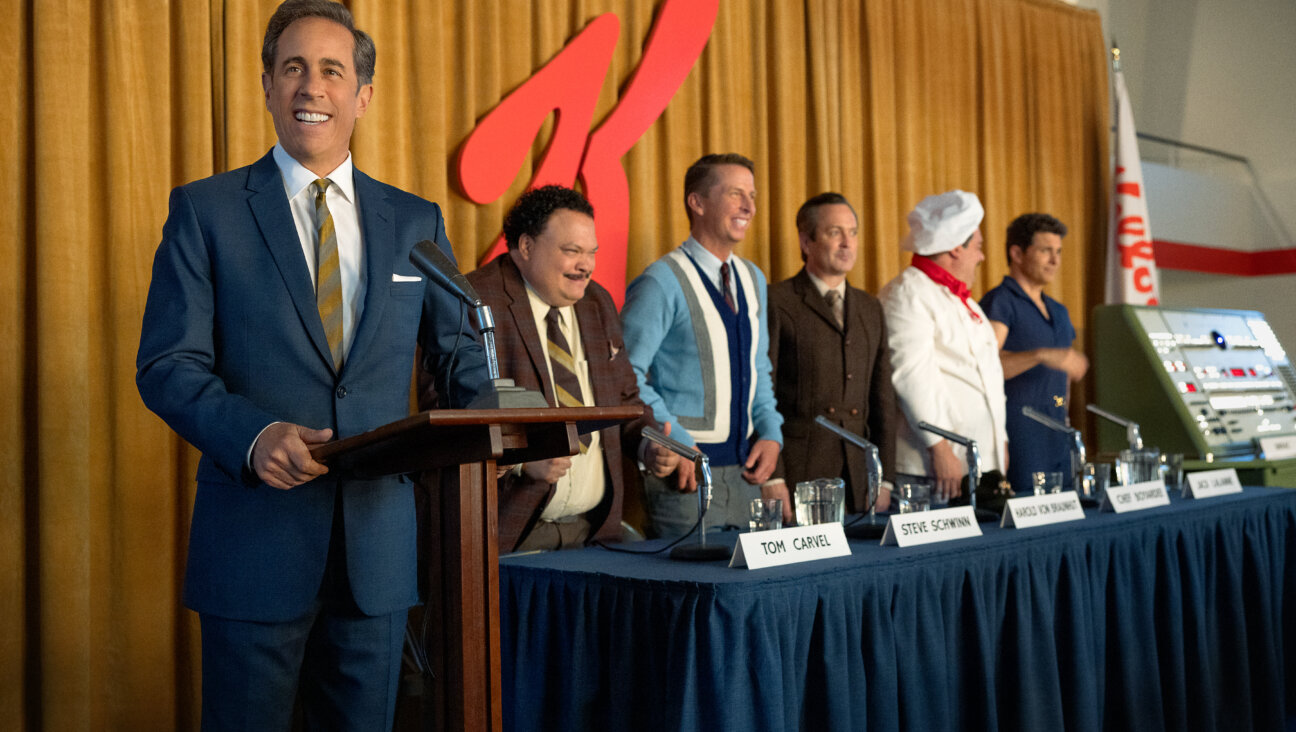EXCLUSIVE: The Improv King Of America

Image by Getty Images/Forward Montage
Imagine Ilsa refusing to leave Rick in “Casablanca.” Or if, in “When Harry Met Sally,” after Sally faked her orgasm, the lady in the diner had left in disgust instead of saying, “I’ll have what she’s having.” Imagine if, in “Being There,” one of Ben’s friends sees through the error and tells everyone that Chance isn’t making profound statements of insight; he’s just talking about gardening.
Nightmares where co-stars refuse to perform keep Sacha Baron Cohen awake at night as he prepares his shows, in which his characters star against their cast. His goal: to convince subjects who have no lines, no story — indeed, no compulsion to keep talking to him at all — to condemn themselves from their own mouths.
So, when Sacha invited me, an old friend of his and a journalist, to sit in a Las Vegas hotel room while he and his crew were setting up a shoot for his show, “Who Is America?” I didn’t think twice about saying yes. I wanted to see the making of an episode from soup to nuts. I wanted to see how he did it. And I ended up being the only journalist on set for the whole series.
What I saw, in a way that television audiences can’t see in the brief five- or 10-minute edits that get broadcast, was the sustained improvisational comedy at the heart of the show. Over the years, Sacha and his writers have come up with some cute lines (“Fashion saves more lives than doctors,” “How loud was the Big Bang?” and “[Liberals use] school shootings to further their anti-tragedy agenda”), but his true achievement is to inhabit absurd characters believably over extended periods of time with people who are not in on the joke.
That means Sacha fits into no clear pre-existing genre. He is no stand-up delivering jokes, no late-night comic host whose guests know what is expected of them; he’s no Jerry Springer-like straight man to the bizarre. Rather, he’s the master of extended improv in enemy territory. Even as his comments get more absurd (“Let’s see if we can stop all these anti-gun people from getting people killed”) his characters convince politicians, celebrities and bizarre salespeople, activists, experts and townsfolk that his characters are real, credible and worth answering.
Given his personas and mischief, his interviews are less like Morley Safer scoring a key interview for “60 Minutes” than like Bart Simpson convincing Alex Jones to come to Springfield for a school debate about truth in journalism. Because what has made this latest show even harder for Sacha is that the move from Ali G to Mossad agent Erran Morad has taken him from character to caricature.
Yet, despite walking around for hours with a slab-jawed rubber prosthesis as Morad (whatever his variable rank), Sacha somehow still succeeds in getting prominent American figures to advocate guns for kindergarteners.And, in other guises, he manages to convince a gallery curator to donate pubic hair for art and a Trump supporter to hide in a piñata and dress up as a 15-year old Mexican girl to entrap “illegal immigrants” who just want “sex” and “drugs.”
The comedy and the outrage come from subjects’ responses to Sacha’s increasingly unacceptable prompts. Pushing the limits in “Who Is America?” Gio Monaldo, a carefree Euro-pimp Italian character, gets “Bachelor” star Corinne Olympios to tell viewers, counterfactually, that she had been in Sierra Leone for a month working for an Ebola charity and had headed off a warlord with tales of her reality TV show.
In a subsequent show, Gio nudges a luxury yacht salesman to sell him a vessel for President Assad of Syria — the mass-murdering, chemical-weapon-using reason for the massive Syrian refugee crisis. To add insult to injury, the salesman agrees — while Gio is visibly pleasured by his girlfriend in front of him — to make custom additions adapting the vessel into a fully armed sex-slave trafficking yacht.
I wasn’t expecting much in a hotel room the day before a Gio shoot: perhaps the director, the director of photography and a couple of hands moving around furniture or setting up cameras. But what I saw was symphonic: Sacha directed his cast and crew around the living area of a palatial Vegas suite, meticulously analyzing every aspect of the shoot, moving in and out of the furniture as he and his guest might, trying to foresee any eventuality.
Ninety percent of the cast of “Who Is America?” has no script or reason to perform, and the crew are tactically absent, so the set needs to be as perfect as possible. When you are in charge of so little of the performance, you need to control what you can. I’ve known Sacha as a professional comedian for 25 years, so I know about his perfectionism as creator, producer and performer, but this was a timely reminder of the lengths to which he and the team had to go to produce the effortless-seeming conversation with O.J. Simpson.
When any of Sacha’s alter egos sits down with a subject, anything can happen. Though for Sacha the meeting was an attempt to elicit a confession, for Simpson, it might end up feeling like an interrogation. But the face time, the action between the guest and absurd character, is the ore that the production must mine. So, whether it lasts 10 minutes or a whole day, it’s crucial that the cameras capture the best of what happens. For a covert filming, cameras need to catch every angle, no matter where the guest moves. But, equally, they need to be invisible: One camera revealed means the whole shoot is compromised.
The Setup
Weeks earlier, Sacha was on the phone getting some advice from a man described as one of the FBI’s most famous interrogators. Not only comedy but also truth and justice are at stake in “Who Is America?” Do celebrities lie? How evil a product will a salesman sell? Will elected representatives espouse absurd policies that they had barely heard? And now, how can the comedian get a confession from Simpson?
The details of the sting that Sacha hopes to secretly film are as follows: The representative of a Middle Eastern billionaire wants to make a million-dollar proposition to Simpson. That’s why he’ll be in the room. But once he’s there he will hear that the offer is $1.4 million to tell the sheikh in a private conversation, while the sheikh has sex with a prostitute. how he, Simpson, murdered his victims. The key is that Simpson must confess to Gio so that the sheikh knows his private audience will be worth it.
Simpson isn’t going to confess straight up, the interrogator says. Gio’s not that convincing — indeed no one is convincing enough to get the man acquitted of the most famous murder in the past half-century to just say, “Yes, I did it.” Instead, the FBI man says, Sacha needs to just keep “moving the pieces around,” keep being plausible and keep Simpson comfortably off-balance, off the defensive. For example, the setting, the verbal cues and also the action need to subtly convey the wealth that Gio’s backers are offering.
Gio’s girlfriend, Christina, is an excellent cover for Gio’s Italianness, making it seem like he understands Italian — and her exit provides cover for the first (and funniest) mention of the murder. But then she is gone and the intensive solo improv begins. Gio does exactly what he’d planned: He moves the pieces around, but Simpson persistently laughs his denials while sipping champagne. There was no confession.
Simpson was at the hotel, being secretly filmed, for more than two hours. For two minutes at the hotel he was with the lawyer, the rest with Gio and the production team. Playing along with Gio’s moral-free European playboy character, Simpson’s bonhomie accompanies insistent denials to tens of allusions to the murder of Nicole Brown Simpson. Simpson is flippant about Gio’s seeming admission of uxoricide; he does agree to some absurd terms for future events — he will attend a party where the billionaire will sleep with a “hooker” — but nothing more damning. In fact, his performance provides a more compelling case for his innocence than either of his trials had.

Sacha Baron Cohen as Erran Morad. Image by Courtesy of Four by Two
That’s because Gio, like Morad, like Sacha’s liberal buffoon Dr. Nira Cain-N’Degeocello — and like Ali G, Bruno and Borat before them — is an amplifier. Innocuously shaped, and plausibly performed, these characters encourage and amplify the guests’ words and actions. Through his embodiment of non-PC culture (or, with Cain-N’Degeocello, with extreme PC-culture), Sacha negates the constrictions of the politically correct.
A conversation with Gio is a chance to indulge in unacceptable locker room talk. A chat with Morad is a chance to say what you really think about guns, Muslims, gay men and lesbians, and immigrants. A chat with Sacha’s characters is like a visit to a reverse psychiatrist, giving you an opportunity to meet the worst angels of your nature.
The Payoff
In 1963, Stanley Milgram, a Yale scientist, did a series of experiments to see how far people were prepared to follow orders to harm another person. He found out that people would press a button to apply increasingly large electric shocks when instructed by an actor playing the part of a figure of ostensible authority.
In our age of disruption, it’s not necessarily obedience to authority that drives people to act. With his new show Sacha has set out to see whether – for money, for social media approval or to satisfy whatever narrow passion passes for ideology — people are as able to say or do hurtful things to strangers as they were 55 years ago.
A boat salesman agrees to weaponize a sex-slavery vessel; the former governor of Arizona says that a 21 year old with a mental age of 3 should be able to buy a gun for ethnic cleansing; food reviewer Bill Jilla happily eats and reviews the flesh of a Chinese dissident; and, most shockingly, Glenn, the Trump Twitter troll of the show’s finale, is prepared to press a button to explode and kill someone he believes is antifa.
The virtue of Sacha’s prolonged improv is that it brings people’s words or actions into real life. By bringing caricatures to life, he’s making people live, in the flesh, their social media lives. Either their beliefs are confronted with absurd opposition that they need to accommodate, or their opinions are so reinforced by Sacha’s character that they take them to unacceptable lengths, even murder.

When Sacha meets people whose beliefs are clear and socially acceptable — like Utah Republican David Pyne, Laguna Beach art gallerist Christy Cones and Vermont senator Bernie Sanders — the joke is on him. The absurdity comes from the questions, and the laughs are at the expense of the caricature he embodies. But when a limited amount of chat with a rubber-faced stranger is enough to convince people of means to lie, encourage deadly play in kindergartens, provide dictators with murderous ships and engage in rampant bigotry in the name of immigrant hatred, well, then the target of the improv changes.
“Who is America?” is the question the show insistently poses. And what we realize from the guests of this show is that Americans really don’t know the answer. Sadly, even in a sting situation it’s more likely that Chance will reveal those around him than be unmasked himself.
Sacha’s talent is to make it appear to the nation that it doesn’t take much more than an afternoon with one of his plausible idiots — from Borat to the cast of “Who Is America?” — to show how dangerous and exactly who America is.
Dan Friedman is the executive editor of the Forward.

I hope you appreciated this article. Before you go, I’d like to ask you to please support the Forward’s award-winning, nonprofit journalism during this critical time.
Now more than ever, American Jews need independent news they can trust, with reporting driven by truth, not ideology. We serve you, not any ideological agenda.
At a time when other newsrooms are closing or cutting back, the Forward has removed its paywall and invested additional resources to report on the ground from Israel and around the U.S. on the impact of the war, rising antisemitism and the protests on college campuses.
Readers like you make it all possible. Support our work by becoming a Forward Member and connect with our journalism and your community.
Make a gift of any size and become a Forward member today. You’ll support our mission to tell the American Jewish story fully and fairly.
— Rachel Fishman Feddersen, Publisher and CEO
Join our mission to tell the Jewish story fully and fairly.

























